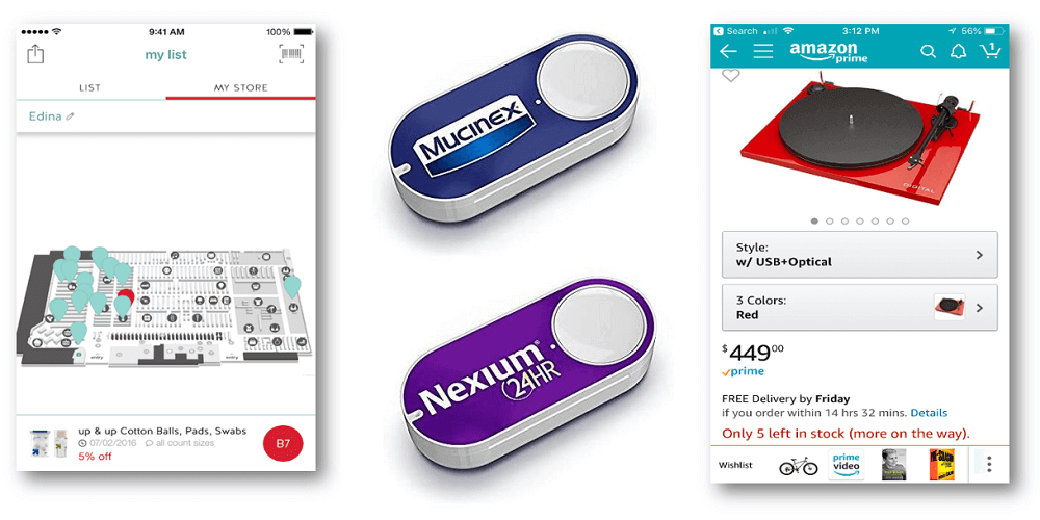“Any sufficiently advanced technology is indistinguishable from magic.” Arthur C. Clarke
This iconic quote from Clarke certainly applies to the modern world of the retail supply chain and recent developments almost seem like magic: one-hour pickup, curb-side delivery, placing orders inside a customer’s home or from a car trunk, all fantastic options which may have seemed far-fetched only a decade ago.
Retail is a fast-moving, competitive landscape and retailers strive for a seamless customer supply chain experience. Magic can’t be counted on to close the gap between channels, but technology can! With the holidays just around the corner, shoppers may be avoiding the rush by staying out of brick and mortar stores; leaving a fantastic opportunity for retailers to benefit from omnichannel shopping habits.
What does omnichannel mean?
Omnichannel is a set of new operations (on the left in the image below) that typically support the shopper journey, such as “buy online, get delivery at home and return in store.”
Shoppers may not be familiar with the term omnichannel, so think of it in realistic terms: how can a merchant make the shopping journey more convenient and memorable for the buyer, without being annoying or creepy?
Some great examples of omnichannel in practice include Target’s app buyers can browse the selection online at any time,add items to their shopping cart, then head to the local Target store. The app will then display an indoor navigation map of the shop, with pinpoints showing the location of the basket items. It’s basically an indoor Google Maps for buyers, providing both them and Target with unprecedented visibility into the shopping journey!
Supply chain visibility is key to omnichannel success. Most players in the supply chain market have come to realize that they need to operate differently in a real-time world, where they need 100% visibility into inventory, operations and the customer journey. As you can see in the image below, we’re not quite there yet. Retailers need to invest in technologies such as the Internet of Things (IoT) to reach that depth of information and agility into supply chain visibility.
The benefits of digitization in an omnichannel supply chain
Hyper-local inventory
No national advertising required! Instead, by focusing on the purchase trends at each store location, you can create personalized local assortments and product mixes. Buyers see one version of inventory status across all channels, online and offline; inventory maintenance at individual store level is transparent and made available online so customers see the products that each store has in stock, which they can then buy online or pick up in store. Omnichannel services allow customers to shop how and when they want.
Last-mile fulfilment
Making products available to omnichannel shoppers requires perfect execution and advanced technology. This is absolutely crucial to win consumers. Here are a few considerations for retailers: Can you implement click-and-collect profitably? Speed up last-mile delivery? Manage the last link in the supply chain with speed and efficiency, while ensuring high customer satisfaction? Some of the best results in fulfilment options include direct to consumer fulfilment from the retailer’s distribution center, a ship to store option from the distribution center for consumer pick-up, a store-to-store transfer for pickup in the final destination store, in-store purchase of online inventory for shipment direct to consumer, among others.
Collaborative supply chain
It’s not possible for every retailer to accomplish all the things that Walmart/Target/Amazon are doing, without collaborating. There are a lot of retailers such as Wegmans, Costco and Whole Foods that have partnered with 3rd party fulfillment vendors. An interesting case for collaboration is Starbucks, who are guaranteeing that 99% of its coffee is ethically sourced; to do that, they had to create a way to track sources and ensure compliance. They’re using real-time blockchain technology to do so! All of their partners that they collaborate with, need to be part of that platform.
3 things to consider for your priority list
Take into consideration the brilliant example of Target’s indoor navigation map, integrated in their mobile app. It enables shoppers to search for in-store inventory and map the location of the items at the aisle level in all their nearly 2,000 North American retail locations. By using indoor maps in your store this will provide your shoppers with enhanced visibility and convenience for their journey as well as providing you (and your last-mile fulfilment partners such as DoorDash) with invaluable insight into their customer journey in-store.
The Amazon Dash button is another interesting case for retailers by offering a similar solution that does NOT use Amazon for fulfilment. Amazon Dash button orders are a huge market, with more than $1B being spent quickly and conveniently by Dash customers. Many brands can attribute more than half their sales to Amazon.com, coming from Dash buttons. Now imagine what other retailers can gain by introducing their own interpretation of the simple yet effective IoT device, via which you have direct access to your shoppers in their home! New, inexpensive wireless technologies like NB-IoT, there’s no need to connect through the consumer WiFi router and worry about support costs.
Lastly, having very accurate visibility into inventory in real-time is crucial for the omnichannel shopping experience. When viewing an item on Amazon.com, inventory is clearly displayed, reassuring shoppers that the article is currently in stock. Very few other companies are actually able to do this, but this level of accuracy into in-store and distribution center inventory is critical for a seamless buying journey.
Visiting NRF 2019 in January? Come see us at booths 1325,1824 and say hi.
Coming soon
Stay tuned for the next blog in this series: How Arm has tackled omnichannel data visibility.

Leave a Reply